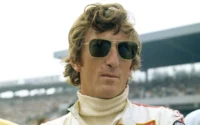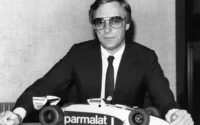Ronnie Peterson was a shining talent in F1 who met a tragic end too early in his career. He had previously secured a second-place finish in the Drivers’ championship during only his second F1 season.
| Nationality | Swedish |
|---|---|
| Born | Bengt Ronnie Peterson 14 February 1944 Örebro, Sweden |
| Died | 11 September 1978 (aged 34) Milan, Italy |
Initially advancing from karting, Peterson ascended to Formula Three, clinching the Swedish championship in 1968. He progressed to the European series the following year, drawing Formula One’s attention by securing a victory in Monaco.
In 1970, Peterson undertook a dual campaign in Formula Two and selected Formula One races. Though this year brought modest results, his perseverance paid off with a works drive for March in 1971.
Despite not winning a race that year, four second-place finishes propelled him to second in the championship standings behind the formidable Jackie Stewart. He also competed in Formula Two, where he captured four victories and the championship title.
March’s 1972 season was less successful with the problematic 721X chassis, which Peterson raced only three times before switching to the more competitive 721G. His performance in this car, especially a commendable third at the Nurburgring, impressed Lotus team owner Colin Chapman, who offered Peterson a seat for 1973 alongside reigning champion Emerson Fittipaldi. Despite a rocky start to the season, Peterson rebounded to secure seven podiums, including four victories, with his initial win at Paul Ricard marking a significant breakthrough.
However, he couldn’t clinch the championship, as Jackie Stewart edged out the Lotus duo. Fittipaldi, feeling overshadowed by his new teammate, departed for McLaren at the end of that season.
Peterson then became the lead driver for Chapman’s innovative designs, though this role didn’t fully align with his strengths. He managed three wins with the ageing Lotus 72 models in 1974, but the new 76 models proved challenging. The team continued with the 72 for another year in 1975, but Peterson struggled and failed to secure any podium finishes, prompting him to consider other options.
In 1976, he rejoined March after a collision with new teammate Mario Andretti at the season opener in Interlagos. Impressively, he drove the 761 chassis to a victory at Monza and planned a move to Tyrrell in 1977.
Despite the challenges of the unconventional six-wheeled P34, Peterson achieved a podium finish with it at Zolder. A return to Lotus was arranged for 1978, albeit in a supporting role to Andretti.
During Peterson’s absence, Lotus had perfected its ground effect 78 chassis. The team was dominant that season, with Peterson winning in South Africa and Austria. As the season reached Monza, Andretti was poised to win the championship.
However, a chaotic start led to a multi-car crash at the 1978 Italian Grand Prix, with Peterson’s car hitting a barrier. He sustained severe leg injuries and awaited an ambulance for about 20 minutes. Despite surgical efforts in Milan, complications from bone marrow entering his bloodstream ultimately led to his untimely death.
Ronnie Peterson Formula One World Championship career
| Active years | 1970–1978 |
|---|---|
| Teams | March (inc. non-works), Tyrrell, Lotus |
| Entries | 123 |
| Championships | 0 |
| Wins | 10 |
| Podiums | 26 |
| Career points | 206 |
| Pole positions | 14 |
| Fastest laps | 9 |
| First entry | 1970 Monaco Grand Prix |
| First win | 1973 French Grand Prix |
| Last win | 1978 Austrian Grand Prix |
| Last entry | 1978 Italian Grand Prix |
Ronnie Peterson Teammates
| 14 Teammates | Involvement | First Year | Last Year |
|---|---|---|---|
| Andrea De Adamich | 8 | 1971 | |
| Alex Soler-Roig | 5 | 1971 | |
| Nanni Galli | 9 | 1971 | |
| Niki Lauda | 13 | 1971 | 1972 |
| Mike Beuttler | 1 | 1971 | |
| Emerson Fittipaldi | 15 | 1973 | |
| Jacky Ickx | 24 | 1974 | 1975 |
| Tim Schenken | 1 | 1974 | |
| Jim Crawford | 2 | 1975 | |
| Brian Henton | 3 | 1975 | |
| John Watson | 1 | 1975 | |
| Mario Andretti | 15 | 1976 | 1978 |
| Hans-Joachim Stuck | 15 | 1976 | |
| Patrick Depailler | 17 | 1977 |
Race Wins
| Win Number | Grand Prix |
|---|---|
| 1 | 1973 French Grand Prix |
| 2 | 1973 Austrian Grand Prix |
| 3 | 1973 Italian Grand Prix |
| 4 | 1973 United States Grand Prix |
| 5 | 1974 Monaco Grand Prix |
| 6 | 1974 French Grand Prix |
| 7 | 1974 Italian Grand Prix |
| 8 | 1976 Italian Grand Prix |
| 9 | 1978 South African Grand Prix |
| 10 | 1978 Austrian Grand Prix |
Complete Formula One results
| Year | Entrant | Chassis | Engine | 1 | 2 | 3 | 4 | 5 | 6 | 7 | 8 | 9 | 10 | 11 | 12 | 13 | 14 | 15 | 16 | 17 | WDC | Pts |
|---|---|---|---|---|---|---|---|---|---|---|---|---|---|---|---|---|---|---|---|---|---|---|
| 1970 | Antique Automobiles Racing Team | March 701 | Ford Cosworth DFV 3.0 V8 | RSA | ESP | MON 7 | BEL NC | NC | 0 | |||||||||||||
| Colin Crabbe Racing | March 701 | Ford Cosworth DFV 3.0 V8 | NED 9 | FRA Ret | GBR 9 | GER Ret | AUT | ITA Ret | CAN NC | USA 11 | MEX | |||||||||||
| 1971 | STP March Racing Team | March 711 | Ford Cosworth DFV 3.0 V8 | RSA 10 | ESP Ret | MON 2 | NED 4 | GBR 2 | GER 5 | AUT 8 | ITA 2 | CAN 2 | USA 3 | 2nd | 33 | |||||||
| March 711 | Alfa Romeo T33 3.0 V8 | FRA Ret | ||||||||||||||||||||
| 1972 | STP March Racing Team | March 721 | Ford Cosworth DFV 3.0 V8 | ARG 6 | RSA 5 | 9th | 12 | |||||||||||||||
| March 721X | Ford Cosworth DFV 3.0 V8 | ESP Ret | MON 11 | BEL 9 | ||||||||||||||||||
| March 721G | Ford Cosworth DFV 3.0 V8 | FRA 5 | GBR 7 | GER 3 | AUT 12 | ITA 9 | CAN DSQ | USA 4 | ||||||||||||||
| 1973 | John Player Team Lotus | Lotus 72D | Ford Cosworth DFV 3.0 V8 | ARG Ret | BRA Ret | RSA 11 | 3rd | 52 | ||||||||||||||
| Lotus 72E | Ford Cosworth DFV 3.0 V8 | ESP Ret | BEL Ret | MON 3 | SWE 2 | FRA 1 | GBR 2 | NED 11 | GER Ret | AUT 1 | ITA 1 | CAN Ret | USA 1 | |||||||||
| 1974 | John Player Team Lotus | Lotus 72E | Ford Cosworth DFV 3.0 V8 | ARG 13 | BRA 6 | MON 1 | SWE Ret | NED 8 | FRA 1 | GBR 10 | AUT Ret | ITA 1 | CAN 3 | USA Ret | 5th | 35 | ||||||
| Lotus 76 | Ford Cosworth DFV 3.0 V8 | RSA Ret | ESP Ret | BEL Ret | GER 4 | |||||||||||||||||
| 1975 | John Player Team Lotus | Lotus 72E | Ford Cosworth DFV 3.0 V8 | ARG Ret | BRA 15 | RSA 10 | ESP Ret | MON 4 | BEL Ret | SWE 9 | NED 15 | FRA 10 | GBR Ret | GER Ret | AUT 5 | ITA Ret | USA 5 | 13th | 6 | |||
| 1976 | John Player Team Lotus | Lotus 77 | Ford Cosworth DFV 3.0 V8 | BRA Ret | 11th | 10 | ||||||||||||||||
| March Racing | March 761 | Ford Cosworth DFV 3.0 V8 | RSA Ret | ESP Ret | BEL Ret | MON Ret | SWE 7 | FRA 19 | GBR Ret | GER Ret | AUT 6 | NED Ret | ITA 1 | CAN 9 | USA Ret | JPN Ret | ||||||
| Theodore Racing | March 761 | Ford Cosworth DFV 3.0 V8 | USW 10 | |||||||||||||||||||
| 1977 | First National City Elf Team Tyrrell | Tyrrell P34B | Ford Cosworth DFV 3.0 V8 | ARG Ret | BRA Ret | RSA Ret | USW Ret | ESP 8 | MON Ret | BEL 3 | SWE Ret | FRA 12 | GBR Ret | GER 9 | AUT 5 | NED Ret | ITA 6 | USA 16 | CAN Ret | JPN Ret | 14th | 7 |
| 1978 | John Player Team Lotus | Lotus 78 | Ford Cosworth DFV 3.0 V8 | ARG 5 | BRA Ret | RSA 1 | USW 4 | MON Ret | BEL 2 | ITA Ret | USA | CAN | 2nd | 51 | ||||||||
| Lotus 79 | Ford Cosworth DFV 3.0 V8 | ESP 2 | SWE 3 | FRA 2 | GBR Ret | GER Ret | AUT 1 | NED 2 |
Sources: Wikipedia.com and racefans.net


